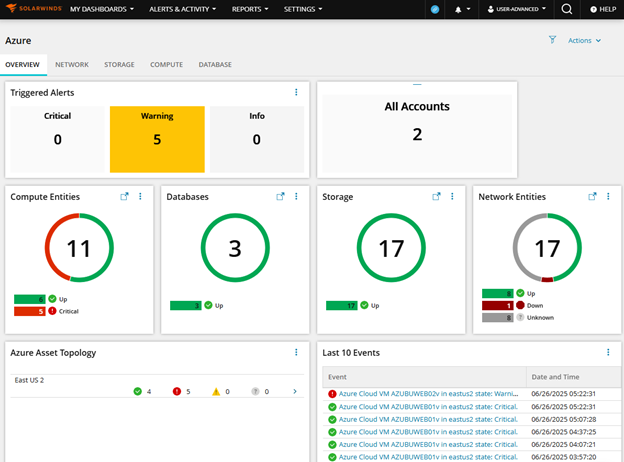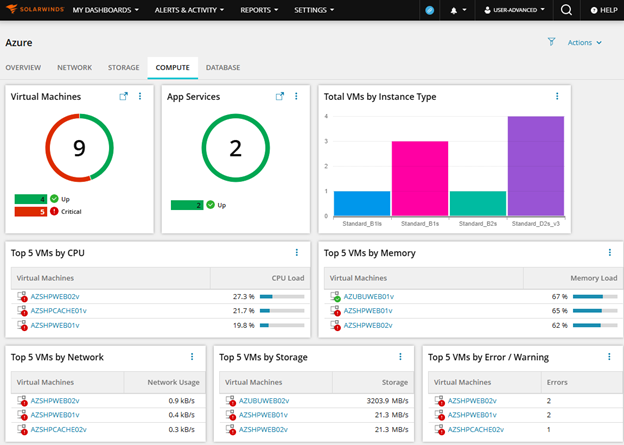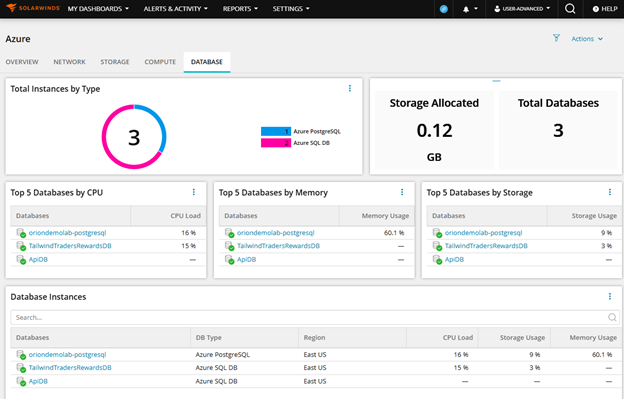Microsoft Azure is a major player in cloud infrastructure, holding 22% of the market as of Q1 2025, and remains a cornerstone of modern business operations. SolarWinds® Observability Self-Hosted offers a broad array of capabilities for monitoring Azure services to ensure customers leveraging Azure maintain optimal performance and observability of their cloud environments. These benefits equip IT teams with the tools they need to gain deep insight into their cloud infrastructure and use that data to support their operations.
This blog explores the benefits, principles, and opportunities of using SolarWinds Observability Self-Hosted for Azure monitoring, highlighting how organizations can achieve full-stack observability, automation, and data-driven insights for their hybrid IT infrastructure.
Overview of Monitored Azure Cloud Services
SolarWinds Observability Self-Hosted provides monitoring for various Azure services, enabling IT teams to gain visibility into compute, network, storage, and database components across their hybrid environment, including their Azure cloud infrastructure and on-premises networks and systems. Specific Azure services that can be monitored include VMs, Azure SQL Database, Blob Storage, App Services, ExpressRoute, and Application Gateway. With SolarWinds Observability Self-Hosted, we unlock full-stack visibility by consolidating data from across your Azure estate into a single view to help you simplify IT management and enhance operational efficiency across your entire IT estate.

Performance Metrics and Resource Utilization in Flexible Configurations
As part of its foundational capabilities, SolarWinds Observability Self-Hosted collects performance metrics and resource utilization data across Azure services via API requests to Azure. This approach ensures real-time data collection and provides deep visibility into resource performance, availability, and usage. For teams requiring specific OS data, such as memory metrics or alternative polling methods, Azure resources can also be managed as nodes using the SolarWinds Platform Agent, WMI, or SNMP.
Types of Collected Real-Time Azure Data
SolarWinds Observability Self-Hosted collects extensive real-time data to provide comprehensive monitoring and insights into your Azure environment, including:
- Performance Metrics: To help identify bottlenecks and optimize resource allocation for business operations, key performance indicators, such as CPU usage, memory consumption, disk I/O, and network latency across Azure VMs and containers, are continuously monitored.
- Network Data: Monitoring network performance, traffic patterns, and availability across Azure Virtual Networks, ExpressRoute connections, and more provides real-time visibility into latency, packet loss, and bandwidth utilization, enabling teams to detect and resolve connectivity issues before they affect business operations.
- Azure Monitor Integration: Combining Azure Monitor metrics and logs with SolarWinds monitoring data provides a comprehensive view of Azure environments and helps contextualize Azure data within the organization’s full IT estate.
- Application Performance: This includes response times, error rates, and transaction volumes from Azure-hosted applications. With automated alerts and suggestions for remediation, this monitoring ensures applications run smoothly and efficiently.
- Security Metrics: These include access logs, network security group configurations, and encryption status, which enable IT teams to identify potential vulnerabilities, focus remediation efforts, and ensure compliance.
- Resource Utilization: This involves usage tracking across Azure compute, network, storage, and database services. This capability helps teams optimize cloud spending by identifying underused or over-provisioned resources.

These examples illustrate the breadth and depth of real-time data we collect, empowering organizations to gain deep insights into their Azure environments, strengthen resilience, and promote operational excellence.
Additional Benefits of Azure Monitoring With SolarWinds Observability Self-Hosted
By unifying Azure monitoring with other IT environments, SolarWinds Observability Self-Hosted enhances operational efficiency, simplifies cloud management, and lowers the mean time to resolution.

Advanced Azure Monitoring Capabilities
Automated Alerts and Anomaly Detection
SolarWinds Observability Self-Hosted leverages intelligent analytics to streamline and automate monitoring processes. After establishing a baseline for typical IT usage behavior, the platform delivers tailored, automated alerts and anomaly detection to help IT teams proactively address potential issues. For example, if an Azure service experiences an unexpected spike in CPU usage or a sudden drop in network throughput, SolarWinds Observability Self-Hosted automatically notifies IT personnel. This proactive approach supports faster issue resolution and reduces downtime.
Customizable Dashboards and Azure Integration
IT teams can create custom dashboards to display the most relevant metrics for their Azure environment, making it easier to monitor performance and identify trends. SolarWinds Observability Self-Hosted integrates directly with Azure Monitor and combines its metrics and logs with other performance data to enable enhanced monitoring and analysis.

Enhanced Security and Compliance Monitoring
Security monitoring is essential in Azure environments, particularly given the rise of malware, identity-based attacks, and shadow IT. SolarWinds Observability Self-Hosted provides visibility into key security metrics, including access logs, network security group configurations, and encryption status. IT teams can use this data to identify potential vulnerabilities and maintain compliance with industry standards.
Scalability for Growing Cloud Environments
SolarWinds Observability Self-Hosted scales with growing Azure deployments, offering the flexibility needed to monitor increasing numbers of Azure services and resources. Whether teams are extending their hybrid infrastructure or migrating more workloads to the cloud, the platform’s architecture supports enterprise-scale environments without compromising performance or reliability.
Latest Azure Enhancements in SolarWinds Observability Self-Hosted
SolarWinds continues to expand Azure monitoring capabilities. Recent enhancements include support for Azure ExpressRoute monitoring, enabling teams to track the performance and availability of dedicated Azure connections. The new Azure Application Gateway monitoring feature offers insights into web application delivery and load balancing performance. To support these capabilities, we’ve redesigned the Cloud Summary Dashboard with more intuitive visualizations and improved performance for monitoring large-scale Azure environments.
Practical Benefits for Azure Operations
Accelerated Migration and Modernization
SolarWinds Observability Self-Hosted helps organizations migrate to Azure faster and with less risk by providing comprehensive visibility into their architecture. Teams can baseline performance before and after migration to identify and resolve issues before they impact production workloads. This approach reduces the time required for cloud adoption while minimizing operational disruption.
Cost Optimization and Resource Management
The platform helps teams optimize Azure spending by identifying over-provisioned instances and underutilized services. Automated analytics reduce manual monitoring overhead and enable IT teams to improve capacity planning accuracy, making data-driven decisions to control Azure costs without sacrificing performance.
Microsoft Ecosystem Integration
For organizations using multiple Microsoft technologies, SolarWinds Observability Self-Hosted provides unified monitoring across Azure infrastructure, Office 365 services, and on-premises Microsoft environments. This reduces training requirements and provides consistent monitoring experiences across your entire Microsoft technology stack.
How to Add Azure Monitoring to SolarWinds Observability Self-Hosted
Adding Azure monitoring to SolarWinds Observability Self-Hosted is straightforward. Simply set up an Azure cloud account and select the services to monitor. Here are the steps:
- Gather credentials from the Azure portal.
- Add the cloud account to the SolarWinds Observability Self-Hosted Platform Web Console.
- Configure the cloud account to interact with the SolarWinds Platform by selecting the Azure services you’d like to monitor in the SolarWinds Observability Self-Hosted Wizard.
Once configured, teams can explore cloud instances and VMs on the Cloud Summary page, providing a comprehensive view of the Azure environment.

Maximizing Azure Investments
Whether you’re beginning your Azure journey or optimizing an existing deployment, SolarWinds Observability Self-Hosted provides comprehensive monitoring capabilities to maximize your Azure investment and maintain reliable operations.